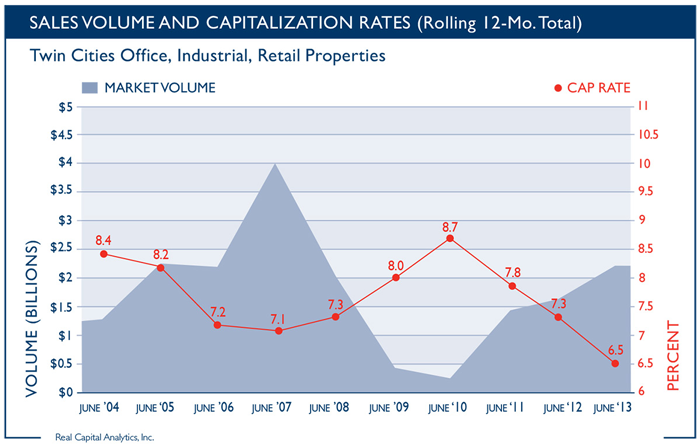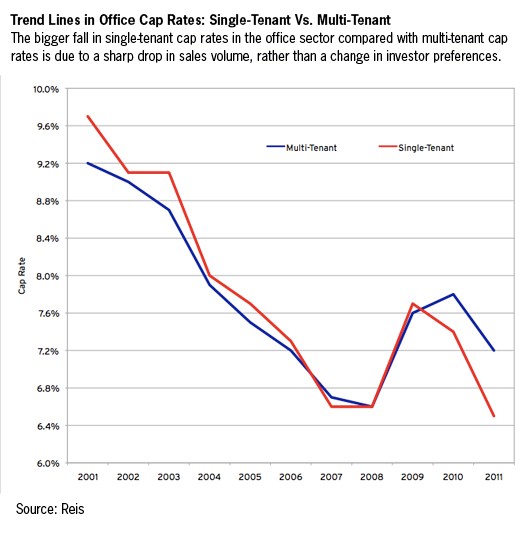Using Cap Rates in Real Estate Investing
Post on: 23 Июнь, 2015 No Comment

If you are new to real estate, you are probably wondering about some of the terms you have heard at your real estate investment group or seen on the Internet. Understanding these terms is important to successful real estate investing. One of these terms is Cap Rate. Cap Rate is short for Capitalization Rate. Effectively, the Cap Rate is the rate of return provided, prior to financing, by the cash flow of an investment property.
The equation to determine the Cap Rate (CR) of a property looks like this:
NOI/FMV = CR, where NOI is net operating income from the property and FMV is the fair market value of the property.
Let me give you a simple example.
Suppose you purchase a property for $500,000. And suppose your net operating income, after operating expenses but before any interest, principle or depreciation, is $50,000. Your Cap Rate is 10%, i.e. 50,000/500,000.
Now, this is your Cap Rate because you know what you paid for the property and you know its cash flow. But, what about the Market Cap Rate? The Market Cap Rate is the average Cap Rate that an investor in a specific market expects for a certain type of property.
You may wonder, What is the significance of the Market Cap Rate for my property? Well, as Market Cap Rates go up, values go down. Conversely, as market cap rates go down, values go up. We can see this simply by restating the formula as follows:
NOI/CR = FMV
Let’s take a look at our example when the Market Cap Rate changes.
Suppose the Market Cap Rate for your property goes from 10% to 7%. What does that mean for the value of your property? To find out, simply divide your net operating income (NOI) by the Cap Rate. So, 50,000/.07 = $714,000. Your property’s value went from $500,000 to over $700,000 through no effort of yours, but simply because the Cap Rate went down.
Conversely, suppose the Market Cap Rate goes from 10% to 12%. What does that mean for the value of your property on the open market? Again, simply divide the NOI by the Cap Rate. So, $50,000/.12 = $417,000 So, the value of your property has decreased because the Market Cap Rate has increased.
What causes the Market Cap Rate (MCR) to change? It’s simply a matter of supply and demand. The more demand for investment property, the lower the MCR. The lower the demand for investment property, the higher the MCR.
So what should the Cap Rate of a property mean to you?

A Cap Rate should tell you two things. The first is how leverage will affect your investment. As long as your Cap Rate is higher than your borrowing cost (interest rate), then you should borrow as much as possible with respect to the acquisition and/or holding of that property. However, if your Cap Rate is less than your borrowing cost, then you should either pay cash for the property or find a different property to buy.
You should also monitor your property Cap Rates to help you determine when you should sell. You should probably sell the property if the Cap Rate falls below your borrowing cost. Why? Because in opportunity cost, you are losing money. Here is an example:
Let’s say you purchased your property for $500,000 when the Market Cap Rate was 10%. And let’s say your mortgage is at 7%. Now, suppose the MCR goes to 5%. What should you do? You should probably sell the property.
At this point, the property is worth $1,000,000. Let’s say you want to maximize your Velocity of Money, so you refinance to a total of $800,000. Your NOI is still $50,000. But you are paying 7% on your money. So now, your interest is $56,000 but your income is only $50,000 so you have negative cash flow of $6,000. With the MCR below your borrowing cost, borrowing out the equity puts you in a negative cash flow position. Instead, you should look at the advantages of selling the property and purchasing a new property with a higher Cap Rate.
Of course, there are some things you can do to increase the value without regard to the Cap Rate. Your value will increase any time you increase your NOI. If you can make changes to your property to increase the rent or to decrease expenses, you will increase the value of your property even if your Cap Rate stays the same.
But any time your cap rate gets lower than your borrowing rate, you should consider selling the property. Many people in Phoenix and California got caught in this trap in the mid-2000’s. Cap rates were at an all time low; some as low as 3-4%. These same people lost many of their properties to foreclosure because they could not make the negative cash flow payments.
So pay attention to the Cap Rate in your market for your investments. If Cap Rates are low, it may be time to sell. If Cap Rates are high, it may be a great time to buy more property in your market. A good real estate broker can give you a pretty good idea of the cap rate for your property.














